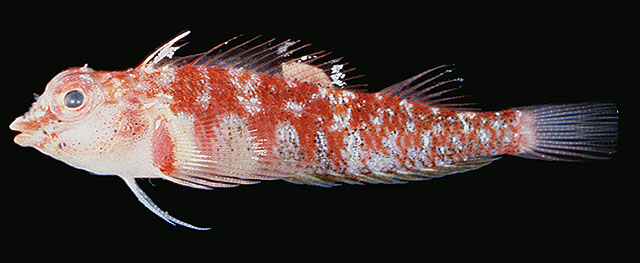| Tripterygiidae (Triplefin blennies), subfamily: Tripterygiinae |
| 4.5 cm SL (male/unsexed) |
|
reef-associated; marine; depth range 0 - 17 m |
| Southwest Pacific: Australia, Vanuatu, Fiji, then east to American Samoa, and the French Polynesia. |
|
Dorsal spines (total): 14-17; Dorsal soft rays (total): 7-11; Anal spines: 1-1; Anal soft rays: 17-21. Small and slender supraorbital tentacle; in males, first spine of first dorsal fin higher than first spine of second dorsal fin; in females, first dorsal fin a little less than 50% shorter than second dorsal fin; females whitish, with fine black dots, bearing a reticular red or brown pattern, isolating the white into 2-3 longitudinal rows of blotches; male coloration similar but generally darker. Dorsal rays III + XI-XIII + 7-10; lateral line interrupted, 14-20 + 14-21; mandibular pores 3-4 + 1 + 3-4 (Ref. 54980). |
| Female members of the Tripterygiidae have eggs that are hemispherical and covered with numerous sticky threads that anchor them in the algae on the nesting sites (Ref. 240). Larvae are planktonic which occur primarily in shallow, nearshore waters (Ref. 94114). |
|
Least Concern (LC); Date assessed: 03 May 2010 Ref. (130435)
|
| harmless |
Source and more info: www.fishbase.org. For personal, classroom, and other internal use only. Not for publication.
